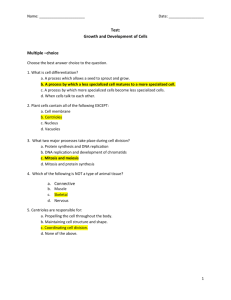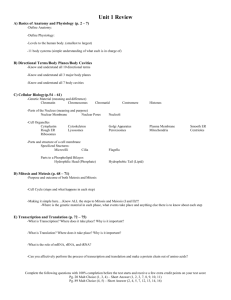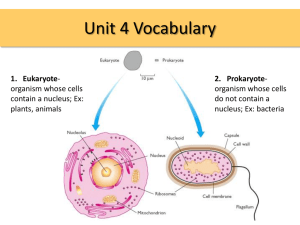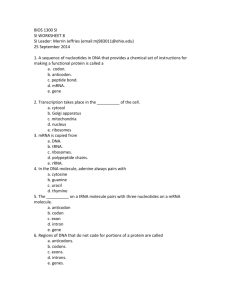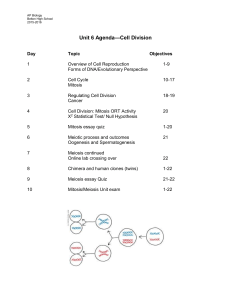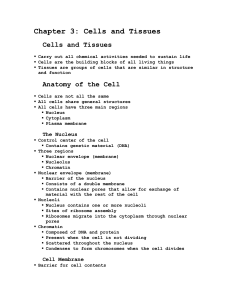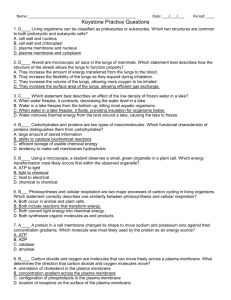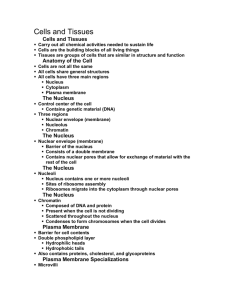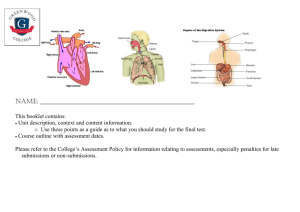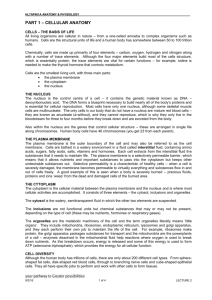Name: : Test: Growth and Development of Cells Multiple –choice
advertisement
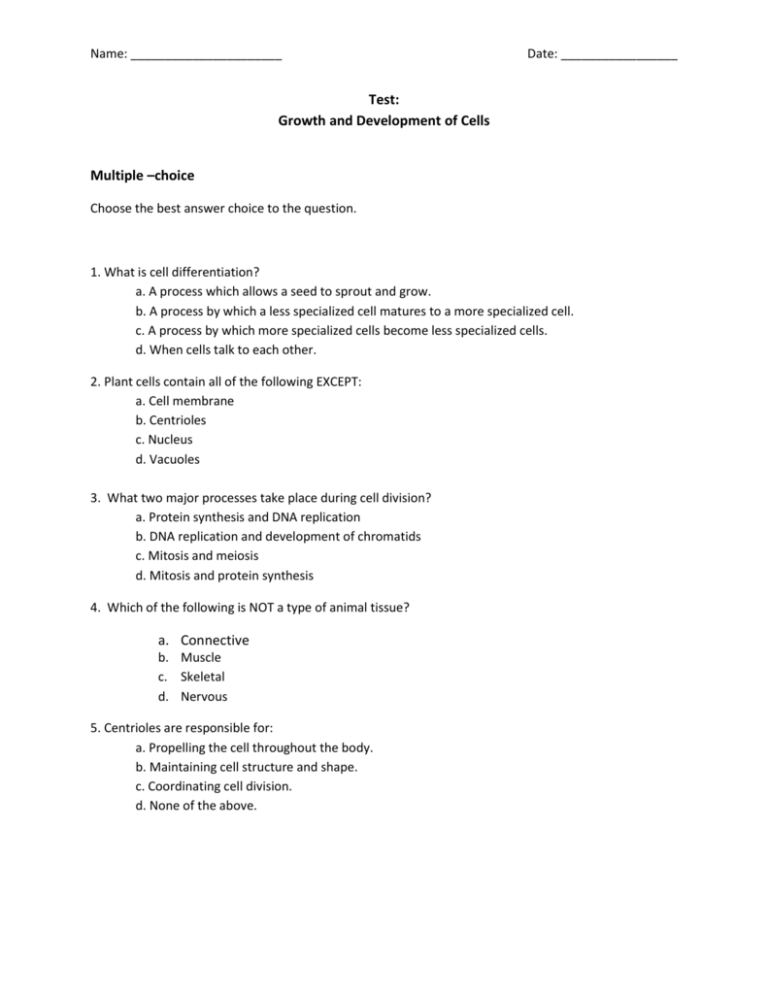
Name: ______________________ Date: _________________ Test: Growth and Development of Cells Multiple –choice Choose the best answer choice to the question. 1. What is cell differentiation? a. A process which allows a seed to sprout and grow. b. A process by which a less specialized cell matures to a more specialized cell. c. A process by which more specialized cells become less specialized cells. d. When cells talk to each other. 2. Plant cells contain all of the following EXCEPT: a. Cell membrane b. Centrioles c. Nucleus d. Vacuoles 3. What two major processes take place during cell division? a. Protein synthesis and DNA replication b. DNA replication and development of chromatids c. Mitosis and meiosis d. Mitosis and protein synthesis 4. Which of the following is NOT a type of animal tissue? a. Connective b. Muscle c. Skeletal d. Nervous 5. Centrioles are responsible for: a. Propelling the cell throughout the body. b. Maintaining cell structure and shape. c. Coordinating cell division. d. None of the above. Name: ______________________ Date: _________________ 6. Which of the following is not a reason cellular organization is important? a. Living organisms need to do things in order to survive b. Cellular organization allows for one organ system to work the hardest at maintaining homeostasis c. Different parts of the body take care of chores to keep itself running. d. All parts work together in harmony to keep the animal alive. 7. How do cells communicate with each other? a. They send chemical messages through the cell’s wall b. They send chemical messages to the nucleus of cells c. They send chemical messages to each other through genes d. They send physical messages to each other 8. How are genes turned “on”? a. Loosening of DNA strands to allow chemical messages to tell the cell exactly what to do b. DNA strands tighten and absorb the information from chemical messages c. The nucleus opens up and lets the messages in d. Cell division allows genes to be turned on 9. The actual splitting of the daughter cells into two separate cells is called ________________ and occurs differently in both plant and animal cells. a. Cell division b. Cytokinesis c. Diploid d. Mitosis 10. Each of the following belongs to only bacteria except: a. Capsule b. Flagellum c. Pili d. Rhibosome 11. A cell that contains two sets of chromosomes: a. Diploid b. Haploid c. Chromatid d. Daughter cell Name: ______________________ Date: _________________ 12. What is an example of connective tissue? a) b) c) d) Bone Striated Muscle Ligament All of the above are examples. 13. A cell that contains one complete set of chromosomes: a. Diploid b. Haploid c. Chromatid d. Daughter cell 14. A ________ is the basic structural and functional unit of all living organisms. a) b) c) d) Atom Cell Organelle None of the above 15. Which of the following is the most active tissue in the body? a) Muscle b) Epithelial c) Skeletal d)Connective Short Answer Write in the correct term(s) or definition to the following questions. 16. List three examples of specialized cells. 17. Living cells are divided into two types. What are the two types? Name: ______________________ Date: _________________ 18. Describe protein synthesis in your own words. 19. Explain the difference between “specialized” cells and “unspecialized” cells. 20. Which two cells contain a nucleus, and which one does not? 21. Discuss two differences between mitosis and meiosis. 22. List the phases of mitosis. 23. List the phases of meiosis I and meiosis II. Name: ______________________ Date: _________________ Labeling 24. Label the correct parts of the cell on the diagram below. a. b. c. d. ______________________________ ______________________________ ______________________________ ______________________________ e. f. g. h. ______________________________ ______________________________ ______________________________ ______________________________ Name: ______________________ Date: _________________ True/False Determine whether the following statements are true or false and circle the answer. If false, justify why. 25. Examples of prokaryotic cells are plant and animal cells. 26. Cardiac muscle can be found on the inner lining of muscle. 27. Both animal and plant cells contain a cell wall. T or F T or F T or F 28. Cells grouped together to form a tissue are not always identical. 29. An atom can only be negatively charged. T or T or F F 30. A cytoplasm is found in a plant, animal and bacterial cell. T or F Matching Match the words in the word bank with the questions below.. ___________________31. One of the tiny, threadlike, DNA-containing bodies found in the cell nuclei of all plants and animals, responsible for transmitting hereditary characteristics. ____________________32. The semi permeable membrane that encloses the contents of a cell; plasma membrane ____________________33. A membranous enclosure within a cell that contains substances isolated from the protoplasm, such as dissolved acids ____________________34. Fluid Filled Interior of Cell, Suspends cell organelles ____________________35. Contains genetic information. Controls all cell activities. ____________________36. Produces the ribosome’s. ____________________37. Produces cellular energy in the form of ATP ____________________38. Transport system within the cell, Two types: Rough and Smooth ____________________39. Collects, packages and modifies cell materials to be used in other parts of the cell or transported out of the cell ____________________40. Digests and recycles old cell parts. Name: ______________________ Word Bank: Cytoplasm Endoplasmic Reticulum Nucleus Chromosome Mitochondria Nucleolus Cell Membrane Lysomes Vacuole Golgi Apparatus Date: _________________

